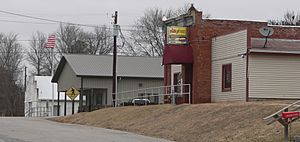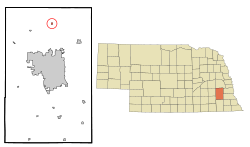Davey, Nebraska facts for kids
Quick facts for kids
Davey, Nebraska
|
|
|---|---|
|
Village
|
|

Downtown Davey: east side of 2nd Street
|
|

Location of Davey, Nebraska
|
|
| Country | United States |
| State | Nebraska |
| County | Lancaster |
| Area | |
| • Total | 0.15 sq mi (0.40 km2) |
| • Land | 0.15 sq mi (0.40 km2) |
| • Water | 0.00 sq mi (0.00 km2) |
| Elevation | 1,296 ft (395 m) |
| Population
(2020)
|
|
| • Total | 135 |
| • Density | 876.62/sq mi (337.43/km2) |
| Time zone | UTC-6 (Central (CST)) |
| • Summer (DST) | UTC-5 (CDT) |
| ZIP code |
68336
|
| Area code(s) | 402 |
| FIPS code | 31-12280 |
| GNIS feature ID | 2398686 |
Davey is a small village in Lancaster County, Nebraska, United States. It is part of the larger Lincoln, Nebraska area. In 2020, about 135 people lived there.
Contents
History of Davey
Early Settlers and the Pony Express
The first European settlers in northern Lancaster County were Irish immigrants. Later, people from Denmark and Sweden also moved to the area. This happened after the Homestead Act of 1862, which allowed people to claim land.
The area was first called Rock Creek. In 1871, it even had a Pony Express station. The Pony Express was a fast mail service that used riders on horses. In 1875, a Danish Lutheran church was built here.
How Davey Started
The village of Davey officially began in 1886. This happened when the Fremont, Elkhorn and Missouri Valley Railroad built train tracks through Rock Creek. The town was named after Michael Davey, an early resident.
Growing Pains and Progress
By 1891, Davey was a busy place! It had many businesses, including:
- a place to keep horses (livery barn)
- an ice house
- a meat market
- a barber shop
- a two-story opera house for shows
- a doctor's office
- a candy shop
In 1900, a newspaper called the Davey Mirror started being published. A bank, the Farmers State Bank of Davey, opened in 1903.
Challenges and Changes
In 1919, a big fire started at the local Catholic church. It spread and burned many buildings in town, including the bank and the telephone office.
Later, in the 1930s, a community building called the Davey Hall was built. This was part of a government program called the WPA. People celebrated its opening with a two-day festival!
Over time, some things changed. The only grocery store, Hansen's Grocery, closed in 1965. The last train passed through Davey in 1981. Today, the old train tracks are now a hiking trail for everyone to enjoy.
Geography of Davey
Davey is a small village. According to the United States Census Bureau, the total area of the village is about 0.15 square miles (0.40 square kilometers). All of this area is land.
Population and People
| Historical population | |||
|---|---|---|---|
| Census | Pop. | %± | |
| 1920 | 123 | — | |
| 1930 | 154 | 25.2% | |
| 1940 | 125 | −18.8% | |
| 1950 | 112 | −10.4% | |
| 1960 | 121 | 8.0% | |
| 1970 | 163 | 34.7% | |
| 1980 | 190 | 16.6% | |
| 1990 | 160 | −15.8% | |
| 2000 | 153 | −4.4% | |
| 2010 | 154 | 0.7% | |
| 2020 | 135 | −12.3% | |
| U.S. Decennial Census 2012 Estimate |
|||
Davey's Population in 2010
In 2010, there were 154 people living in Davey. These people lived in 61 different homes, and 40 of these were families. The village had about 1027 people per square mile.
Most people in Davey were White (96.8%). A small number were from other backgrounds. About 1.3% of the population was Hispanic or Latino.
Homes and Families
Out of the 61 homes:
- 26.2% had children under 18 living there.
- 54.1% were married couples living together.
- A few homes had a single parent (female or male).
- About 24.6% of homes had just one person living there.
- About 8.2% of homes had someone 65 years or older living alone.
On average, about 2.52 people lived in each home. For families, the average was about 3.18 people.
Age Groups in Davey
The average age of people in Davey in 2010 was about 39.6 years old.
- 26% of residents were under 18 years old.
- 6.4% were between 18 and 24 years old.
- 25.3% were between 25 and 44 years old.
- 26.6% were between 45 and 64 years old.
- 15.6% were 65 years or older.
More males lived in Davey than females in 2010. About 54.5% of the population was male, and 45.5% was female.
See also
 In Spanish: Davey (Nebraska) para niños
In Spanish: Davey (Nebraska) para niños

